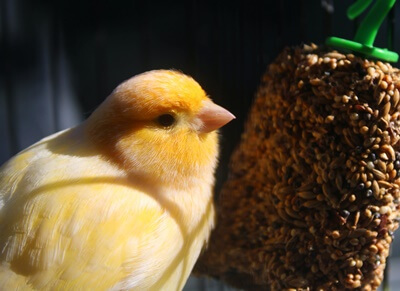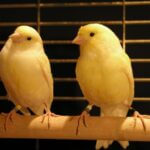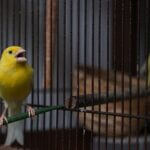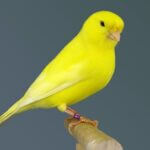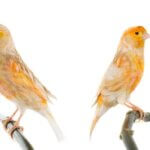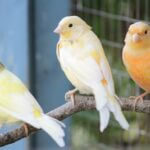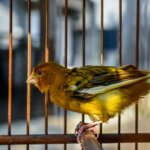Canaries are monomorphic, which means both sexes appear almost identical. So, it’s hard for even the most seasoned bird expert to distinguish male and female canaries.
A canary’s ability to lay eggs is the most obvious way to distinguish between males and females.
Determining the sex is important since it gives you greater control over their breeding. If you keep two canaries together, avoid certain gender combinations, such as two males.
How To Tell A Canary’s Gender
Differentiating between boy and girl canaries can be difficult, even for the most experienced owners, largely because both sexes have similar physical features.
The only guaranteed way to tell the sex of a canary is by observing whether it lays eggs. Only female canaries lay eggs, so many owners are surprised to discover that their male canary is a female.
Even if a female is kept on her own or hasn’t mated, she’ll still lay unfertilized eggs during the breeding season (early March to late July). These eggs will never hatch, even if you were to incubate them.
Most canaries lay eggs three times annually in clutches of 3-5 eggs.
Physical Differences
While male and female canaries have similar physical traits, there are minor differences that can enable you to find out a canary’s sex, including:
Plumage Color
Canaries have a variety of colors, the most common being yellow canaries and red-factor canaries.
While both sexes of the same species have similar plumage colors, males have brighter and more colorful plumage than females.
Physical Build
Male canaries can be distinguished from females by their slimmer, more athletic build and upright posture. However, females are smaller, and their heads and bodies are more rounded.
Cloacal Opening
The cloaca of male and female canaries appear identical for most of the year.
However, there’s a subtle difference in their shapes during the mating season. While the cloaca of a female maintains a flat and rounded appearance, the male’s cloaca will appear elongated.
Although it’s possible to tell the sex of a canary by looking at its cloaca, timing is crucial.
The physical difference in the shape of the cloaca will be most apparent during the peak of the breeding season. This makes this sexing method less reliable than others.
By examining its cloaca during the peak breeding season, you can tell if your canary is male or female. To do so, blow the feathers around your canary’s underside to make its sexual organs visible.
If your canary’s cloaca appears elongated or bulging, it’s likely a male. However, if you notice the cloaca is flat and rounded, it’s likely a female.
Behavioral Differences
Aside from the above physical differences, you can determine the gender of a canary based on its behavioral traits, including the following:
Singing
Male canaries are the more prolific songbirds of the two sexes because they sing louder and more frequently than female canaries.
According to Behavioral and Neural Biology, male canaries start to develop their adult song during the onset of sexual maturity, which is around 8-12 months after hatching.
The song development of canaries has three stages:
- Subsong
- Plastic song
- Full (stable) song
According to the Manual of Exotic Pet Practice, singing in male canaries is to attract potential mates and mark territory.
Singing in male canaries is an important feature in mate selection. So, males will produce their strongest and most melodic songs to attract partners and increase their chances of mating.
Although hens sing, they produce less prominent or melodious songs. Even so, hormonal conditions, such as a spike in testosterone, may cause a female to mimic the singing characteristic of males.
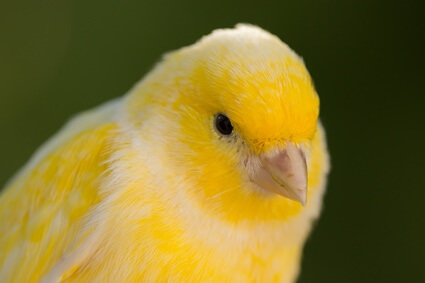
Courtship Behaviors
Male and female canaries exhibit different behaviors during courtship.
If you have different-sex canaries in a shared cage, the male may feed the female directly by regurgitating partially digested food inside her beak.
If two males are in a cage, they’re more likely to become aggressive toward each other. However, males and females don’t always get along well, especially outside of the breeding season.
Females display certain unique behaviors during courtship. For example, they’ll start sourcing materials to prepare a nest in readiness for egg-laying.
How To Vent Sex A Canary
Vent sexing is the practice of manually examining a canary’s reproductive organ to determine its sex.
This method is a fairly reliable way to tell the sex of canaries, particularly new hatchlings whose sexual organs haven’t fully developed.
Here is a simple step-by-step guide on how to vent sex a canary:
- Hold your canary upside down with its head facing you and its tail facing away.
- Lightly blow on the feathers around the vent area, so the cloaca is visible.
- Examine the anatomy of the vent area.
- If the cloaca sticks out or appears bulgy, it’s a male. However, if the cloaca seems rounded and flat, it’s a female.
Differences Between Male And Female Canaries
While male and female canaries have similar outward appearances, they exhibit different physical and behavioral traits.
Here’s an overview of notable differences between the two canary sexes.
| Males | Females | |
| Plumage: | Brighter and more colorful feathers | Duller feathers |
| Body: | Leaner and more athletic | Smaller and stockier |
| Vent: | Elongated or protruding | Flat and rounded |
| Singing: | More sophisticated and frequent | Less melodic and infrequent |
| Nesting: | No apparent nesting behaviors | Prominent nesting behaviors, such as nest-building |
Are Male Canaries Bigger Than Females?
There are noticeable differences between male and female canaries.
However, males tend to be slightly bigger and more athletic in build. They also tend to sit upright on perches, giving the impression that they’re much larger than females.
The size difference between different sexes is negligible, so you can’t rely on it to tell the sex of a canary whose sex you don’t know.
Fortunately, there are more reliable ways of establishing the sex of a canary, such as vent sexing, observing nesting and courtship behavior, and the intensity (or lack) of singing.

